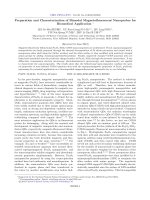Low power high data rate transmitter design for biomedical application
Bạn đang xem bản rút gọn của tài liệu. Xem và tải ngay bản đầy đủ của tài liệu tại đây (6.37 MB, 108 trang )
Low-Power High-Data-Rate Transmitter Design
for Biomedical Application
Liu Xiayun
(B.Eng., UESTC)
A thesis submitted for the degree of Doctor of Philosophy
Department of Electrical and Computer Engineering
National University of Singapore
2014
III
Declaration
I hereby declare that this thesis is my original work and it has
been written by me in its entirety. I have duly acknowledged all
the sources of information which have been used in the thesis.
This thesis has also not been submitted for any degree in any
university previously.
……………………
Liu Xiayun
August, 2014
IV
Acknowledgments
At first, I would like to express my deepest thanks and gratitude to my
supervisor Prof. Heng Chun-Huat for his advice and instruction with kindness
and wisdom on research as well as on personality in the past five years.
Second, my profound thanks must be extended to Dr. Mehran Mohammadi
Izad, as his enthusiasm in research greatly encouraged me. Moreover, thanks
to the abundant discussions with and advices from him, my horizon has been
broadened significantly, both theoretically and experimentally.
Third, my heart-felt thanks also go to my friends Dr. Jun Tan, Dr. Wen-Sin
Liew, Dr. Mahmood Khayatzadeh, Mr. Ti Li, Mr. Lei Wang, Mr. Xiaoyang
Zhang, Mr. Yongfu Li, Ms. Dingjuan Chua, Mr. Wenfeng Zhao, Mr. Jianming
Zhao, Mr. Xuchuan Li, Mr. Rui Pan, Ms. Lianhong Zhou, and Mr. Tong Wu
for their kind help on the study itself, as well as understanding and tolerance
of my heavy equipment occupancy. Besides, I’d like to thank my friend Dr.
San-Jeow Chen, Dr. Yuan Gao for the chance to work with the transmitter
project at Institute of Microelectronics (IME).
Thanks for the Economic Development Board (EDB) IC Design Postgraduate
Scholarship (ICPS).
Lastly, my forever gratitude goes to my parents and husband for their great
love and support.
V
Table of Contents
Introduction 1 Chapter 1
Background 1 1.1
Research Objective 4 1.2
Research Contribution 6 1.3
Organization of the Thesis 7 1.4
Existing TX Designs for Biomedical Application 9 Chapter 2
Transmitter Architecture 9 2.1
2.1.1 Mixer-Based TX 9
2.1.2 Polar TX 11
2.1.3 MUX-based TX 11
2.1.4 ILO based TX 12
Modulation Scheme 14 2.2
Pulse-Shaping Filter 17 2.3
Summary 19 2.4
Design of QPSK/16-QAM Transmitter with Band Shaping 21 Chapter 3
Introduction 21 3.1
Transmitter Architecture 22 3.2
Design Consideration 24 3.3
3.3.1 EVM Consideration 24
3.3.2 Spectrum Consideration 29
Circuit Implementation 32 3.4
3.4.1 Crystal Oscillator 32
VI
3.4.2 Injection-Locked Ring Oscillator 34
3.4.3 Power Amplifier 37
3.4.4 SAR Frequency Calibration 40
3.4.5 FIR Filter Implementation 42
Chip Verification and Measurement Results 44 3.5
Design of Multi-channel Reconfigurable GMSK/PSK/16-QAM Transmitter Chapter 4
with Band Shaping 55
Introduction 55
4.1
Transmitter Architecture 57 4.2
Circuit Implementation 59 4.3
4.3.1 Proposed PIDI Synthesizer 59
4.3.2 Digital Power Amplifier 65
4.3.3 QPSK/8-PSK/16-QAM Band Shaping Modulator 69
Chip Verification and Measurement Results 72 4.4
Conclusion and Future works 79 Chapter 5
Conclusion 79 5.1
Future Works 80 5.2
References 83
VII
Abstract
For implantable and wearable biomedical applications, such as wireless neural
recording and capsule endoscopy, there has been an increasing demand for the
development of wireless transmitter (TX) with low power consumption and
high data rate. In this thesis, two energy-efficient TXs are proposed.
Firstly, a 900-MHz QPSK/16-QAM band-shaped TX will be presented.
Unlike the conventional TX, injection locking coupled with quadrature
modulation is utilized to achieve band-shaped QPSK/16-QAM modulation
with effective sideband suppression of more than 38 dB. Fabricated in 65-nm
CMOS, the TX achieves maximum data rate of 50 Mbps/100 Mbps for
QPSK/16-QAM with 6% EVM, while occupying only 0.08 mm
2
. Under
0.77-V supply, the TX attains energy efficiency of 26 pJ/bit and 13 pJ/bit
respectively with and without activating band shaping.
Secondly, a multi-channel reconfigurable 401~406 MHz GMSK/PSK/QAM
TX with band shaping is realized in 65nm CMOS with an area of 0.4 mm
2
.
Using DLL-based phase-interpolated synthesizer and injection-locked ring
oscillator, the TX attains 1 kHz frequency resolution as well as multi-phase
output without the need of phase calibration. Through direct quadrature
modulation at digital PA, the TX achieves less than 6% EVM for data rate up
to 12.5 Mb/s. The band shaping maximizes the spectral efficiency with ACPR
VIII
of -33 dB. Consuming 2.57 mW, the TX attains an energy efficiency of 103
pJ/bit.
IX
List of Symbols and Abbreviations
ACPR Adjacent Channel Power Ratio
AM Amplitude Modulation
BFSK Binary Frequency-Shift Keying
BS Band Shaping
BW Bandwidth
CSD Canonical Signed Digit
DAC Digital-to-Analog Converter
DLL Delay-Locked Loop
DPA Digital Power Amplifier
M Delta Sigma Modulator
ECG Electrocardiography
EEG Electroencephalography
EMG Electromyography
EVM Error Vector Magnitude
FCC Federal Communications Commission
FIR Finite Impulse Response
FM Frequency Modulation
GFSK Gaussian Frequency-Shift keying
X
GI Gastrointestinal
ICD Implantable Cardioverter-defibrillators
ILO Injection-Locking LC Oscillator
ILRO Injection-Locking Ring Oscillator
LO Local Oscillator
ISI Inter-Symbol Interference
ISM Industrial, Scientific, and Medical
MedRadio Medical Device Radio Communications Service
MEMS Microelectromechanical System
MICS Medical Implant Communication Service
MSps Mega Symbol per Second
MUX Multiplexer
OOK On-Off Keying
O-QPSK Offset Quadrature Phase-Shift Keying
PA Power Amplifier
PIDI Phase-Interpolated Dual-Injection
PLL Phase-Locked Loop
PM Phase Modulation
QAM Quadrature Amplitude Modulation
QFN Quad Flat No Lead
XI
QPSK Quadrature Phase-Shift Keying
π/4-DQPSK π/4-Shifted Differential Quadrature Phase-Shift Keying
RC Raised Cosine
RF Radio Frequency
RO Ring Oscillator
ROM Read Only Memory
RRC Root Raised Cosine
SAR Successive Approximation
TX Transmitter
WBAN Wireless Body Area Network
WLAN Wireless Local Area Network
XII
List of Figures
Fig. 1.1. RF telemetry benefits: operating room. 2
Fig. 1.2. RF TX for a multichannel neural recording system. 3
Fig. 1.3. (a) Diagnostic procedure. (b) Pillcam by Given Imaging. 3
Fig. 2.1. Conventional mixer based TX. 10
Fig. 2.2. Conventional polar TX. 11
Fig. 2.3 A MUX-based TX. 12
Fig. 2.4. Modulation trend for TX above 60 GHz. 15
Fig. 2.5. Comparison of occupied bandwidth for different modulation schemes
at the same data rate. 16
Fig. 2.6. Impulse response of the RC filter. 17
Fig. 2.7. Output spectrum of the recent proposed QPSK TX without RRC vs
TX with RRC. 18
Fig. 2.8. Occupied bandwidth of RC filter with different 18
Fig. 3.1. Proposed TX architecture. 22
Fig. 3.2. Constellation of (a) QPSK (b) 16-QAM 23
Fig. 3.3 (a) Behavior of the sub-harmonic injection-locked oscillator when
ref
fNf .
0
. (b) Effect of phase modulation on the constellation. 26
Fig. 3.4. Effect of injection locking on oscillator in (a) Time domain
perspective. (b) Frequency domain perspective from simulation. 27
Fig. 3.5. MATLAB Simulink model of (a) proposed TX. (b) RX. 30
Fig. 3.6. Output spectrum of (a) Node A (b) Node B(c) Node C. 31
Fig. 3.7. PA bit-length vs. power, EVM, and side-lobe suppression. 31
Fig. 3.8. LC model for crystal. 32
Fig. 3.9. Schematic of the Pierce crystal schematic. 33
XIII
Fig. 3.10 (a) Magnitude and (b) phase response of the crystal oscillator. 33
Fig. 3.11. (a) Implementation of ILRO (b) Pulse slimmer (c) Detailed
schematic of the delay cell. 35
Fig. 3.12. Effect of mismatch filtering resistors. (a) Simplified model. (b)
Waveforms in the ideal case and the presence of mismatch. 36
Fig. 3.13. Monte Carlo simulation for phase mismatch: (a) without resistor
network (b) with resistor network. 37
Fig. 3.14. Digital power amplifier with direct phase and amplitude modulation.
38
Fig. 3.15. Time-domain waveform of PA output (a) without BS (b) with BS. 38
Fig. 3.16. Kick-back noise due to parasitic capacitance. 39
Fig. 3.17. Simulated EVM performance of TX (a) with buffer between ILRO
and PA (b) without buffer between ILRO and PA. 40
Fig. 3.18. Fixed counter window for frequency calibration. 40
Fig. 3.19. SAR algorithm for frequency tuning. 41
Fig. 3.20. Direct form transposed FIR filter. 42
Fig. 3.21. Impulse response of designed RRC filter. 43
Fig. 3.22. Output spectrum of RRC filter with different coefficient bit-length.
44
Fig. 3.23. Simple test setup diagram. 45
Fig. 3.24. Die photo. 45
Fig. 3.25. Measured phase noise under free running and injection locking. 46
Fig. 3.26 Measured settling time 47
Fig. 3.27. Spectrum of ILRO before and after frequency calibration. 47
Fig. 3.28. Measured spurious tones performance of ILRO 48
Fig. 3.29. Measured PA efficiency versus supply voltage. 48
Fig. 3.30. Measured EVM for QPSK/16-QAM at 25 MSps with/without BS. 49
XIV
Fig. 3.31. Comparison of output spectrum with/without BS for QPSK and
16-QAM at 50 Mbps. 49
Fig. 3.32. Measured TX EVM variations versus data rate across 10 chips. 50
Fig. 3.33. Energy efficiency comparison of low-power TXs. 53
Fig. 4.1. Proposed TX architecture. 57
Fig. 4.2. Constellation plot of: (a) QPSK (b) 8-PSK (c) 16-QAM. 58
Fig. 4.3. Block diagram of the PIDI synthesizer 59
Fig. 4.4. Operation of the frequency interpolator. 60
Fig. 4.5. Output spectrum of the hybrid-FIR filter. 61
Fig. 4.6. Block diagram of: (a) 2
nd
-order M with dithering (b) frequency
interpolator. 62
Fig. 4.7. Noise shaping from 2
nd
-order M. 63
Fig. 4.8. Schematic of the relaxation oscillator. 64
Fig. 4.9 Simplified schematic of DPA. 65
Fig. 4.10. Modified schematic of DPA. 66
Fig. 4.11. Current Output of (a) N-branch DPA (b) P-branch DPA (b)
N-branch + P-branch DPA. 67
Fig. 4.12. Simulated spectrum (a) N-branch DPA (b) N-branch + P-branch
DPA 68
Fig. 4.13. Algorithm of QPSK/8-PSK/16-QAM band-shaping modulator. 70
Fig. 4.14. Impulse response of the designed 41 taps RRC filter. 71
Fig. 4.15. Simple test setup diagram. 73
Fig. 4.16. Three adjacent 16-QAM channels output spectrum with 300 kHz
spacing and channel ACPR. 73
Fig. 4.17. Output spectrum of (a) GMSK (b) QPSK (c) 8-PSK (d) 16-QAM
for 187.5 kb/s data rate 74
Fig. 4.18. Measured EVM of GMSK/QPSK/8-PSK/16-QAM at different data
rates. 75
XV
Fig. 4.19. Die photo. 77
Fig. 4.20. TX power breakdown. 77
XVI
List of Tables
Table 3.1. Digital bits for filter design. 44
Table 3.2. TX Power Breakdown. 51
Table 3.3. Performance Comparison. 51
Table 4.1 Example of ROM for QPSK. 72
Table 4.2 Performance Summary and Comparison. 76
.
Chapter 1
1
CHAPTER 1
INTRODUCTION
Background 1.1
Wireless technology has provided great mobility and comfort for people in a
variety of fields such as cellular telephones, wireless local area network
(WLAN) (i.e. Wi-Fi, Bluetooth), GPS units and mobile satellite service
technology used in South Pole, and so on.
In the biomedical area, implantable and wearable medical devices for
measuring physiological signals, e.g. electrocardiography (ECG),
electroencephalography (EEG), electromyography (EMG), and neural signal,
also benefit from the rapid growth of wireless technology. Conventionally,
inductive telemetry is used for these devices. Despite of the low power
consumption, external and implantable devices of these near-field systems
must be closely placed in order to construct the required inductive link. This
greatly restricts the mobility of both patients and doctors. Therefore, far-field
Chapter 1
2
radio frequency (RF) telemetry is proposed to enhance the device
communication range and thus improve the mobility. Zarlink [1] envisages the
future of medical operation, as illustrated in Fig. 1.1, where the RF telemetry
removes the attachment on body surface that limits mobility.
RF telemetry is widely adopted in biomedical area. A typical example is the
wireless implantable multi-channel neural recording system. Simultaneous
neural signal recording is very useful in studying complex neural basis
behavior for the understanding of brain function. One of the potential usages is
to replace the function of an impaired nervous system with artificial devices
for human body. As shown in Fig. 1.2, neural signal collected through arrays
of miniature in-vivo MEMS electrodes will be digitized and transmitted to an
external computer for further classification and processing. As perceived in
this example, the major constraints of the implantable system are the form
factor and total power consumption of the implantable device.
Wireless capsule endoscopy is another interesting application of the RF
telemetry. The wireless endoscopy system shown in Fig. 1.3 [1] was designed
by Given Imaging incorporated with Zarlink Semiconductor. After being
swallowed by the patient, the capsule passes through the digestive tract,
Fig. 1.1. RF telemetry benefits: operating room.
Chapter 1
3
meanwhile the RF transmitter (TX) relays the camera image to a data recorder
attached to the SensorBelt around the patient’s waist which then download the
data to a handheld device that enable real-time gastrointestinal (GI) tract. This
capsule endoscopy can reveal the pathologies and diseases of small intestine
that were otherwise undetectable using traditional diagnostic tools.
Fig. 1.2. RF TX for a multichannel neural recording system.
(a) (b)
Fig. 1.3. (a) Diagnostic procedure. (b) Pillcam by Given Imaging.
Chapter 1
4
Apart from the above two examples, a wearable wireless body area network
(WBAN) also emerges as a key technology for medical and consumer
electronics, especially for healthcare monitoring [2]. Equipped with various
sensors, the patient can be monitored remotely by doctor from time to time
without the need of having the patient visiting the clinic or hospital. The
doctor can easily analyze the patient vital condition based on the acquired vital
signals, e.g. ECG, EEG, EMG, blood pressure, body temperature, etc.
Research Objective 1.2
Although wireless communication systems have been well developed in the
cellular and WLAN domain, these technologies cannot be used directly for
medical application such as WBAN. Since the TX architectures in cellular and
WLAN devices are usually optimized for high performance and long distance
communication, they are too complicated to achieve a small device size and
the strictly regulated emission power level of medical applications. Therefore,
the design and development of energy-efficient RF TX for biomedical
applications is a real challenge.
The first challenge is power consumption. As RF telemetry usually consumes
more power than inductive telemetry, high power consumption implies higher
system cost, weight, and form factor, mainly due to the need of larger power
capacity. Example on low-power devices with small form factor can be found
in pacemaker, implantable cardioverter defibrillator (ICD), and long-range
long-duration untethered animal tracking system. In short, battery-life time of
the implanted device must be extended, and the transceiver needs to be
Chapter 1
5
optimized under limited energy capacity, while maintaining acceptable
performance.
Besides the low power consumption, there is an increasing demand for high
data rate. For example, in the neural recording system, a huge amount of data
needs to be transmitted out of the body to be further analyzed. Normally,
simultaneous recording of the brain function requires more than 100 channels.
The desired raw data rate can be estimated as follow [3] :
(1.1)
where DR is the required data rate, CH is the channel number, f
s
refers to the
sampling frequency, and B is the bit resolution per sample. If a maximum of
128 simultaneous recording channels are used in this system and each channel
is sampled at 40 kS/s with 8-bit resolution, the raw data rate will exceed 40
Mbps. Clearly, as the number of channels increases, precise recording calls for
high data rate as much as 100 Mbps or higher. Similarly, in the endoscopy
system, for real-time high-quality image (typically 640×480 pixels)
transmission with frame rate of 10fps (16 bit color per pixel), the required data
rate is as high as 50 Mbps. In the future, if the frame rate of biomedical images
is upgraded to the currently main frame rate standard (24 fps), which is
identical to TV and movie-making, even higher data rate will be required.
The main objective of this work is to develop a wireless TX with optimized
energy efficiency for biomedical application. Firstly, a novel architecture will
be proposed to save power and cost. Secondly, to enable high data rate
transmission, advanced modulation scheme such as 16-quadrature amplitude
modulation (16-QAM) will be utilized in the TX. Thirdly, to lower the
adjacent channel interference and maximize the spectrum efficiency, the TX
Chapter 1
6
side-lobe will be suppressed. Lastly, the TX will be designed to support
multiple channels.
Research Contribution 1.3
The main contributions of my research works lie in the design of low-power
high-data-rate TX dedicated for biomedical applications.
The first contribution of my works is the design of a 13-pJ/bit 900 MHz
QPSK/16-QAM band-shaped TX. The novelty of this work is that the
injection locking oscillator coupled with quadrature modulation digital PA
offers a very efficient way to achieve band-shaped QPSK/16-QAM
modulation with effective sideband suppression of more than 38 dB, thus leads
to significantly area and power savings. The TX maximum data rate is 50
Mbps/100 Mbps for QPSK/16-QAM with 6% EVM while occupying only
0.08mm
2
active area in a standard 65-nm CMOS technology. Under 0.77-V
supply, the TX achieves energy efficiency of 26 pJ/bit and 13 pJ/bit
respectively with and without activating band shaping. This TX mainly aims
for high data rate applications such as neural recording system and capsule
endoscopy.
The second contribution of my work is the design of a 401~406 MHz
GMSK/PSK/QAM TX with band shaping in a 65-nm CMOS with 0.4 mm
2
active area. With the usage of a DLL-based phase interpolated synthesizer and
an injection-locked ring oscillator, the TX attains 1 kHz frequency resolution
as well as multi-phase output without the need of phase calibration. Through
direct quadrature modulation at a digital PA, the TX achieves less than 6%
Chapter 1
7
EVM for data rate up to 12.5 Mb/s. The band shaping maximizes the spectral
efficiency with ACPR of -33 dB. Consuming 2.57 mW, the TX attains an
energy efficiency of 103 pJ/bit. The TX targets the WBAN with specified
MICS frequency band.
The publications achieved to date are listed below:
[1] Xiayun Liu, Mehran M. Izad, Libin Yao, and Chun-Huat Heng, “A
13pJ/bit 900MHz QPSK/16-QAM Band Shaped Transmitter Based on
Injection Locking and Digital PA for Biomedical Applications,” IEEE J.
Solid-State Circuits, vol. 49, no. 11, pp. 2408-2421, Nov. 2014.
[2] Xiayun Liu, Mehran M. Izad, Libin Yao, and Chun-Huat Heng. "A
13-pJ/bit 900-MHz QPSK/16-QAM transmitter with band shaping for
biomedical application," In Proc. IEEE Asian Solid State Circuits Conf.
(A-SSCC), 2013, pp. 189-192.
[3] Xiayun Liu, Yuan Gao, Wei-Da Toh, San-Jeow Cheng, Minkyu Je and
Chun-Huat Heng, "A 103 pJ/bit Multi-channel Reconfigurable
GMSK/PSK/16-QAM Transmitter with Band-shaping," In Proc. IEEE Asian
Solid State Circuits Conf. (A-SSCC), accepted.
Organization of the Thesis 1.4
This thesis is organized as follows:
Chapter 2 reviews the conventional TX architecture with various modulation
schemes and pulse-shaping filters.
Chapter 1
8
Chapter 3 presents the proposed 900 MHz QPSK/16-QAM band-shaped TX,
including the detailed descriptions and circuit implementation for each of the
functional blocks. The chip verification and measurement results will also be
presented.
Chapter 4 proposes a multi-channel 401~406 MHz GMSK/PSK/16-QAM
band-shaped TX, accompanied by chip verification and measurement results.
Chapter 5 summarizes and concludes this thesis.
Chapter 2
9
CHAPTER 2
EXISTING TX DESIGNS FOR BIOMEDICAL
APPLICATION
Transmitter Architecture 2.1
2.1.1 Mixer-Based TX
Although two-step architecture is widely used in today’s communication
system since it can circumvent the problem of local oscillator (LO) pulling
with superior I/Q mismatch[4], direct-conversion architecture is usually
adopted in low-power systems for biomedical application [3, 5-26], due to its
simplicity and high level of integration.
Fig. 2.1 shows the architecture of a conventional direct up-conversion
transmitter. This quadrature upconverter topology is suitable for both linear
and nonlinear modulation. As illustrated in the figure, the baseband data will








![api design for c+ + [electronic resource]](https://media.store123doc.com/images/document/14/y/qw/medium_qwf1401470661.jpg)
